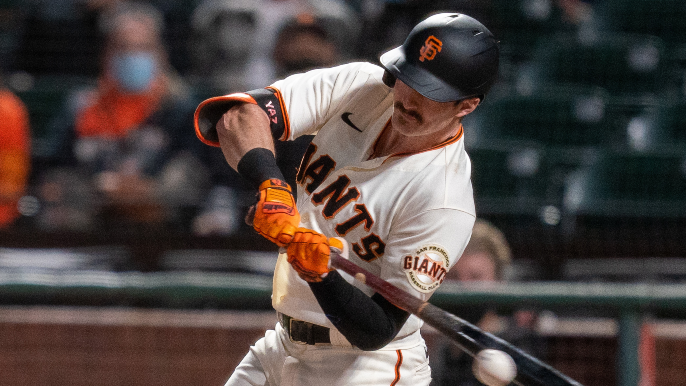
Neville E. Guard-USA TODAY Sports
Having a healthy hand, which was drilled just before the season started, will help. As will a healed oblique after a strain forced him to the injured list until last Friday. Statcast has not yet begun tallying how much a mustache improves a hitter’s offensive game, but the eye test indicates the effect is enormous.
There are reasons to believe Mike Yastrzemski is turning it around, but the player who entered the season regarded as the Giants’ best still is not hitting like he did last year. He is striking out more and walking less, the home runs have not come as consistently and he has become a face of an offense that has shown peeks of its 2020 self but not the whole picture.
“He’s kind of the guy who’s in the lineup that teams know: ‘Hey, don’t let this guy beat us,’” hitting coach Justin Viele said on a recent phone call. “And that’s how he’s getting pitched.”
To begin to understand the lefty hitter’s struggles in 2021, and against lefties in particular, first you must understand all hitters’ struggles in 2021, and lefties against lefties in particular.
Yes, a slugger who emerged as not just the Giants’ MVP but a serious NL contender last year, finishing eighth in voting, is batting .223 with a .324 on-base percentage. But MLB’s average hitter this season is batting .234 with a .311 on-base percentage. Yes, a slugger who emerged as a rare everyday player on a platoon-heavy team by hitting lefties as well as righties has particularly struggled against southpaws, against whom he is 5-for-30 (.167) without a home run. But he is part of a league-wide trend: Lefty hitters are slashing .219/.299/.341 against southpaws this year, lefty pitchers increasingly getting outs with breaking pitches that border on unfair.
“Yaz hasn’t gotten a ton of mistakes,” said Viele, whose main hitting philosophy is to punish mistake pitches and lay off the rest.
What he has gotten is a ton of sliders.
Pitchers have thrown breaking pitches — sliders and curveballs — 32 percent of the time against Yastrzemski, up from 25.8 percent last year. He’s 3-for-32 (.094) against them. The numbers are especially tough with sliders, against which he is 1-for-20 (thanks to Statcast and Fangraphs for the assistance!).
Against lefties’ sliders, he is 0-for-10. Against lefties in general, he is struggling to elevate the ball, a sky-high 66.7 percent groundball rate compared with a 35.4 percent rate against lefties last year. Each of his four home runs this season has come against a righty pitcher. As a top-of-the-lineup bat in an era when every pitch is optimized and the stuff is filthier than ever, he is seeing some of the opposing pitchers’ best offerings and not seeing many fastballs.
He is not alone.
“He’s getting a lot of spin [from lefties], and no one slugs that,” said Viele, who’s in tandem with Donnie Ecker and Dustin Lind as the Giants’ hitting voices. “If people slug that, they wouldn’t throw it as much as they do.”
Pitchers’ dominating stuff and hitters selling out for power, because one home run is easier to come by than stringing three singles together, is a big reason Major League Baseball is experimenting in the minors with ways to juice up action on the field. There is no such thing as a fastball count anymore, and hitters like Yastrzemski will have to adjust.
Perhaps he already has, hitting better since he returned from the injured list, going 4-for-10 with three doubles in his last three games. Of course, San Diego and Texas used opposing righty starters in each game.
“He’s too good, and he makes adjustments too well to not make an adjustment on a left-on-left slider or a righty up and away,” Viele said while Yastrzemski was sidelined. “He’s a survivor in general. He’s always been. That’s why he’s battled through the minor leagues to get to this point to be one of the most dangerous hitters in our lineup. He makes adjustments, and he makes adjustments as well as anyone I’ve ever seen.”
Both righty and lefty pitchers now know to up their slider usage against him, up from 16.5 percent last year to 23 percent this season. Of the 128 pitches lefties have thrown against Yastrzemski, 47 (37 percent) have been sliders, and he’s still searching for his first hit.
Giants hitters the past two seasons have heaped praise on their coaches and analytic minds who have kept them prepared for what’s coming, how an opposing pitcher will attack them. The Giants are not the only offense doing its homework.
Opposing hurlers know what to throw him and know what can happen if they miss. As the Giants visit Pittsburgh beginning Thursday and then Cincinnati, both will circle Yastrzemski in the lineup as a slugger to be careful with.
“That’s the way it’s looked,” Viele said.

